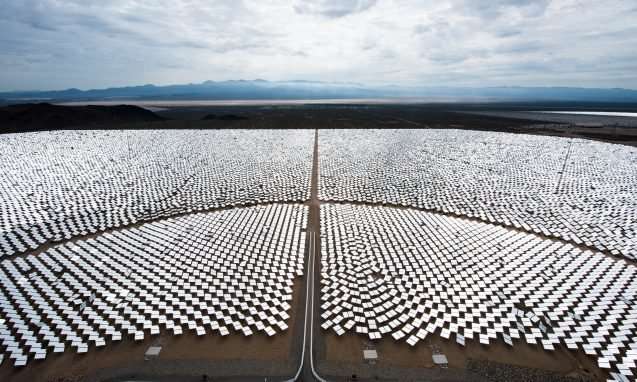How the U.S. might fulfill its Paris pledge without the White House

With President Trump planning to withdraw from the Paris climate agreement, a new poll found that 55 percent of Americans now want their local and state governments to fight global warming. And indeed, states, regions, cities, businesses and colleges are stepping up efforts to reduce carbon emissions in an attempt to meet the pledge the U.S. made at the Paris climate accord.
U.S. carbon emissions fell two percent in 2016 thanks to our increased use of renewable energy instead of coal, but the nation still has a long way to go if it wants to meet its initial Paris target of reducing greenhouse gas emissions by 26 to 28 percent, compared to 2005 levels, by 2025. Non-federal initiatives are trying to close the gap.
States
The United States Climate Alliance, comprised of 14 states (California, Colorado, Connecticut, Delaware, Hawaii, Massachusetts, Minnesota, New York, North Carolina, Oregon, Rhode Island, Vermont, Virginia and Washington) and Puerto Rico, represents more than 36 percent of the U.S. population, $7 trillion in GDP, and 1.3 million clean energy jobs.
These states are all committed to reducing their greenhouse gas emissions in line with the goals of the Paris Agreement. That means they will be producing more energy from renewable sources, such as wind, solar, biomass, and geothermal. They have ambitious energy efficiency policies and standards for buildings and appliances, and most are members of the Zero Emission Vehicle program, which requires them to sell a certain number of electric cars and trucks based on overall vehicle sales in the state. Each state is also conducting vulnerability assessments, and investing in more resilient buildings and infrastructure, coastal and buffer restoration, drought planning and emergency preparedness to deal with climate change impacts.
New York aims to reduce its emissions to 40 percent below its 1990 levels by 2030 and 80 percent by 2050, and to generate 50 percent of its electricity from renewable sources by 2030. California, the first state to establish a cap-and-trade program, has extended that program to 2030 in order to reduce its emissions 40 percent below 1990 levels by then; in addition, all new residential and commercial buildings must be net-zero—meaning they produce as much electricity as they use—by 2020 and 2030, respectively. Oregon plans to phase out coal from its investor-owned electric plants by 2030, and Hawaii has committed to getting 100 percent of its electricity from renewable sources by 2045.
A recent analysis by the Rhodium Group found that between 2005 and 2015, Alliance states had already reduced their collective greenhouse gas emissions by 15 percent, which is more than 50 percent of the way towards meeting their share of the Paris goal. (Moreover, their joint economic output grew 14 percent, outperforming the rest of the country by 2 percent.) The Alliance states are projected to reduce their emissions to 24 to 29 percent below 2005 levels by 2025, in line with the Paris Agreement. But since they currently represent only 36 percent of the nation's population, this means the U.S. would likely cut its overall greenhouse gas emissions by only 15 to 19 percent, falling short of the Paris target unless more states sign on and new policies (whether local, state or federal) are implemented.
However, the states are not alone in striving to meet the Paris goals. We Are Still In is a network of 2,300 leaders of states, counties, cities, businesses, and colleges and universities that are committed to upholding the Paris Agreement. Soon after Trump announced that the U.S. would withdraw from the Paris accord, former New York City Mayor Michael Bloomberg, the U.N. Secretary-General's special envoy for Cities and Climate Change, submitted the "We Are Still In" declaration to the United Nations, pledging that the network would commit to meeting the goals of the Paris Agreement.

Cities
The cities of We Are Still In are taking action through Climate Mayors, an organization of 382 U.S. mayors, and the Global Covenant of Mayors for Climate and Energy. Climate Mayors commit to inventory their cities' greenhouse gas emissions, set targets to reduce emissions in line with the Paris accord, and create an action plan to reach their goals. The 125 U.S. cities in the Global Covenant have committed to reducing their greenhouse gas emissions, enhancing resilience, and tracking their progress in a transparent manner.
Cities are taking a variety of routes to achieve their goals. Santa Monica is requiring that all new homes be net-zero starting this year. Portland and Seattle have banned any additional fossil fuel infrastructure—that means no new pipelines, port facilities, rail lines for transporting fossil fuels, or power plants. Minneapolis will cut emissions by 30 percent by 2025 and 80 percent by 2050. Salt Lake City has a goal to get all its electricity from renewable sources by 2032. And Aspen already uses 100 percent renewable power from hydroelectric, wind, and landfill gas.
Businesses
Almost 50 percent of the largest U.S. companies have one or more clean energy goals, and more than 100 businesses have signed onto the RE100 initiative, with most committing to 100 percent renewable electricity by 2024. Members of RE100 include some of America's most important companies: Bank of America, Mars, Walmart, Kellogg, JP Morgan Chase, General Motors, Goldman Sachs, Coca Cola, Google and Starbucks. The organization's 2016 annual report found that, on average, the companies were halfway toward meeting their goal of 100 percent renewable energy.
Walmart's Project Gigaton is encouraging all its suppliers to collectively eliminate one gigaton of greenhouse gas emissions by 2030 through actions on energy, agriculture, waste, packaging, deforestation, and product use. Citigroup, Bank of America and Goldman Sachs' goals are to be powered by 100 percent renewable energy by 2020; Goldman Sachs reached 86 percent renewable in 2015. Morgan Stanley is aiming for 2022, and Nike is striving for 2025. Biogen, Microsoft, Starbucks, Steelcase, Voya and Workday have already achieved 100 percent renewable energy, and Google, the largest corporate buyer of renewable energy in the world, will reach its goal to have its data centers and offices 100 percent powered by renewables this year.
Through EP100, global businesses are committing to doubling their energy productivity within 25 years—that means producing twice as much with the same amount of energy. If 100 of them succeed by 2030, it will eliminate more than 170 million metric tons of greenhouse gases, and save over $327 billion in yearly energy costs.
Some other initiatives are getting states, cities and businesses to commit to reducing greenhouse gas emissions and helping them achieve their goals. Another is helping companies convert their fleets to electric vehicles.

Colleges and Universities
Presidents of almost 600 colleges and universities in every state and Washington D.C. are participating in the Presidents' Climate Leadership Commitments. They pledge to create climate action plans to achieve carbon neutrality and climate resilience, expand research into these areas, and track their progress. Colleges and universities are becoming test and demo platforms for new clean energy technology. Schools can also become part of the Carbon Credit and Purchasing Program to develop and market carbon credits on campus through energy conservation, energy efficiency, renewable energy, and LEED-certified buildings.
Loyola University Chicago, aiming for carbon neutrality by 2025, has a plan to reduce energy use and obtain energy credits and carbon offsets; it maintains two geothermal installations and 55,000 square feet of green roofs. The University of Vermont, which created a climate action plan in 2010, has reduced its emissions by 28 percent and has set a goal to be 100 percent renewable by 2022. Pennsylvania's Allegheny College, which is aiming for carbon neutrality by 2020, has cut emissions by 62 percent. And Colby College in Maine achieved carbon neutrality in 2015.
Will it Be Enough?
Climate denier Scott Pruitt, the head of the Environmental Protection Agency is rescinding regulations on fossil fuels on a myriad of fronts. President Trump is moving to repeal the Clean Power Plan, which would limit carbon pollution from power plants. Given these rollbacks, will the sum total of climate actions by states, cities, business and universities be enough to meet the U.S. Paris pledge?
Next month, California Governor Jerry Brown and former Mayor Michael Bloomberg hope to answer that question. Their America's Pledge initiative is compiling and quantifying all the actions that states, cities, businesses and universities are taking to reduce greenhouse gas emissions. The results will be announced at COP23, the U.N. climate conference in November. America's Pledge will also provide a plan for expanding the efforts, demonstrating strategies to reduce emissions further.
Steve Cohen, Earth Institute executive director, is optimistic that the U.S. can meet its stated target. "The initial targets are relatively modest and will be met without much difficulty," he said. He expects more challenges in 2020, when the world will set more ambitious targets through 2030. "Once the low-hanging fruit is harvested, the next reductions will be more difficult to achieve and we need to start working now on renewable energy technology, smart grids and battery technology to ensure that climate change can be mitigated over the long term."
Michael Gerrard, director of the Sabin Center for Climate Law at Columbia University, is more doubtful about achieving the near-term target. "Progress is uneven across the country," he said. "Some states are doing well, but others needed the shove from the Clean Power Plan. Going forward, the progress due to market forces is necessary but not sufficient—we will need strong laws to drive the needed transformation of the energy system."
There could still be surprises, however.
"I think you can get these tipping points," said John Furlow, deputy director for Humanitarian and International Development at the Earth Institute's International Research Institute for Climate and Society.
"For example, General Motors announced that it wants to introduce 20 electric vehicle models by 2023, and they're looking at going all electric after that. Ford is following suit. Japan, France and China are going all electric and Jerry Brown is asking why California can't do that, too. This is just to say that there may be tipping points that we're not anticipating and that then federal regulations won't matter so much. Some other company may sign on and tip things over, and it could move Congress or maybe even the President…. I'm hopeful."
Provided by Earth Institute, Columbia University
This story is republished courtesy of Earth Institute, Columbia University http://blogs.ei.columbia.edu.

















